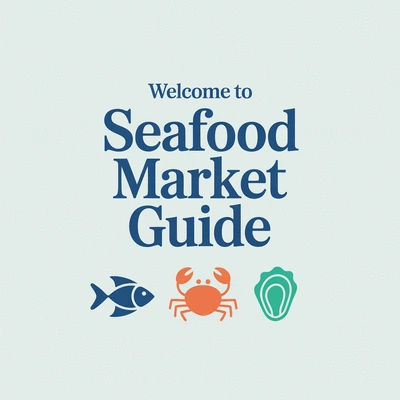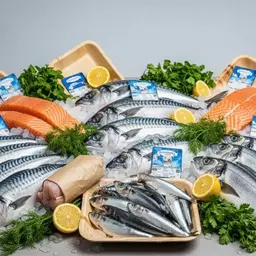Did you know that the seafood choices you make can significantly impact both your health and the health of our oceans? Understanding sustainable seafood is not just a trend; it's a vital part of responsible eating that benefits you, the environment, and future generations. This guide will help you navigate the waters of sustainable seafood, ensuring you make informed decisions at the market.
What You Will Learn
- Sustainable seafood supports marine ecosystems and ensures fish populations are maintained for future generations.
- Familiarity with seafood certifications (like MSC and ASC) helps consumers make responsible purchasing decisions.
- Incorporating sustainable seafood into your diet provides numerous health benefits, such as improved heart health and cognitive function.
- Choosing local and sustainable seafood can enhance flavor, nutritional value, and community support.
- Engaging with resources like Seafood Watch can empower you to make informed choices and advocate for sustainable practices.
Exploring Nutritional and Environmental Benefits of Sustainable Seafood
Sustainable seafood offers significant health and environmental advantages worth highlighting. Below is a visual representation that outlines the key comparisons between sustainable and conventional seafood. For more insights on making environmentally conscious choices, explore sustainable seafood choices in Australia.
Nutritional Benefits
- Higher levels of Omega-3 Fatty Acids
- Lower risk of contaminants
- Fresher seafood due to responsible sourcing
Environmental Impact
- Supports healthy fish populations
- Minimizes habitat destruction
- Encourages responsible fishing practices
Community Support
- Boosts local economies
- Promotes local fishing traditions
- Connects consumers with sustainable sources
Flavor and Quality
- Often more flavorful
- Encourages experimentation with fresh ingredients
- Enhances culinary experiences
Understanding Sustainable Seafood: A Guide for Home Chefs
As a seafood enthusiast and the founder of Seafood Market Guide, I believe that understanding sustainable seafood is essential for every home chef. Sustainable seafood not only supports our oceans but also offers us a chance to enjoy nutritious meals. In this guide, we’ll explore what sustainable seafood means, its health benefits, and how to make informed choices when selecting seafood for your next meal.
What Does Sustainable Seafood Mean?
Sustainable seafood is about ensuring that the fish and seafood we consume are sourced in a way that maintains the health of marine ecosystems. This means using methods that don’t deplete fish populations or harm the habitats they live in. Have you ever thought about the impact of your seafood choices? Understanding sustainable fishing practices can help you make decisions that benefit both your plate and the planet.
Defining Sustainable Fishing Practices
Sustainable fishing practices encompass a variety of methods aimed at reducing environmental impact. These practices include:
- Responsible Harvesting: Catching fish in a way that allows populations to regenerate.
- Bycatch Reduction: Minimizing the capture of unintended species during fishing.
- Habitat Protection: Avoiding methods that damage ocean habitats.
By embracing these practices, fishermen can maintain fish stocks for future generations, ensuring that seafood remains a viable food option. It's exciting to see local markets, which I often highlight on Seafood Market Guide, prioritize these methods and offer consumers the freshest, sustainably sourced seafood. To learn more about selecting sustainable fish, check out our guide on selecting sustainable fish at markets.
The Importance of Seafood Certifications (e.g., MSC, ASC)
When shopping for seafood, look for certifications that indicate sustainable practices. Some key certifications to consider include:
- Marine Stewardship Council (MSC): Focuses on wild-caught seafood that meets sustainability standards.
- Aquaculture Stewardship Council (ASC): Ensures responsible farming practices in aquaculture.
- Best Aquaculture Practices (BAP): Covers environmental and social responsibility in farmed seafood production.
These certifications provide assurance that you’re making a responsible choice. When I visit seafood markets, I love witnessing how vendors proudly display certifications, making it easier for consumers like you to choose sustainably sourced options.
Nutritional Benefits of Choosing Sustainable Seafood
Choosing sustainable seafood is not just good for the environment; it’s also a smart choice for your health! Seafood is packed with essential nutrients that play a vital role in a balanced diet. Have you considered how incorporating sustainable seafood into your meals can enhance your overall well-being?
Health Advantages of Seafood in Your Diet
Seafood is a rich source of several vital nutrients, including:
- Omega-3 Fatty Acids: Important for heart health and brain function.
- Protein: Essential for building and repairing tissues.
- Vitamins: Such as vitamin D and B12, important for overall wellness.
Incorporating sustainable seafood into your diet can help you reap these benefits while supporting responsible fishing practices. It’s a win-win situation that I’m passionate about promoting through Seafood Market Guide. For tips on finding the freshest options, see our advice on choosing fresh seafood at markets.
Comparing Nutritional Profiles: Sustainable vs. Conventional Seafood
When comparing sustainable seafood with conventional options, you might find that the nutritional profiles are quite similar. However, sustainably sourced seafood often has a lower risk of contaminants, making it a safer choice. Here are some factors to consider:
- Lower Contaminant Levels: Sustainable seafood tends to have less exposure to pollutants.
- Freshness: Sustainable seafood is often fresher, as it is caught or farmed with environmental care in mind.
This emphasis on quality makes sustainable seafood not only a healthier option but also one that celebrates the richness of our oceans. When I prepare seafood dishes at home, I feel good knowing I’m choosing ingredients that are both nourishing and sustainable.
Exploring the Nutrition of Seafood: Health Benefits
Adding seafood to your diet can lead to a variety of health benefits, such as:
- Improved Heart Health: Regular consumption of seafood can reduce the risk of heart disease.
- Enhanced Brain Function: Omega-3s are known to support cognitive health.
- Stronger Bones: Vitamins and minerals found in seafood contribute to bone density.
As someone who values marine sustainability, I find it rewarding to share these insights with readers. Choosing sustainable seafood not only enriches our meals but also fosters a healthier lifestyle!
Pro Tip
When shopping for seafood, always ask your fishmonger about the sourcing practices of their products. Not only does this promote transparency, but it also encourages vendors to prioritize sustainable options. Engaging with your local seafood market is a great way to ensure you're making informed choices!
Frequently Asked Questions About Sustainable Seafood
- What is sustainable seafood?
- Sustainable seafood refers to fish and shellfish that are caught or farmed in ways that do not harm the environment, deplete fish populations, or damage marine habitats, ensuring their availability for future generations.
- Why should I choose sustainable seafood?
- Choosing sustainable seafood offers both health and environmental benefits. It supports healthy marine ecosystems, reduces the risk of consuming contaminated seafood, and often provides fresher, more nutritious options. It also helps preserve fish stocks and supports responsible fishing communities.
- How can I identify sustainable seafood?
- Look for certifications from organizations like the Marine Stewardship Council (MSC) for wild-caught seafood, the Aquaculture Stewardship Council (ASC) for farmed seafood, or Best Aquaculture Practices (BAP). These labels indicate that the seafood meets specific sustainability standards.
- What are the nutritional benefits of sustainable seafood?
- Sustainable seafood is rich in essential nutrients such as Omega-3 fatty acids, protein, and vitamins (like D and B12). These contribute to improved heart health, enhanced brain function, and stronger bones. Sustainably sourced seafood often has lower contaminant levels due to better environmental management.
- Where can I find resources to learn more about sustainable seafood?
- Reputable resources include Seafood Watch, the Marine Stewardship Council (MSC), and Community-Supported Fisheries. You can also visit local seafood markets and ask vendors about their sourcing practices to make informed choices.
Key Takeaways on Preparing Sustainable Seafood
As we wrap up our exploration of sustainable seafood, it's crucial to reflect on the numerous nutritional and environmental benefits that come with making responsible choices. Choosing sustainable seafood not only supports your health but also helps protect the oceans and their ecosystems. By understanding these benefits, we can make informed decisions that contribute to a better future for our planet.
First and foremost, sustainable seafood options are often richer in essential nutrients, which can lead to better health outcomes. They are sourced in ways that maintain fish populations and the health of marine environments. Remember, your choices at the seafood market can have a lasting impact on both your plate and the ocean!
Recap of Nutritional and Environmental Benefits
Choosing sustainable seafood offers a multitude of advantages:
- Healthier Choices: Sustainable seafood is typically fresher and packed with nutrients.
- Environmental Impact: It supports the health of ocean ecosystems and fish populations.
- Community Support: Purchasing from local, sustainable sources boosts the local economy.
- Flavorful Meals: Sustainable options are often more flavorful and vibrant in your dishes.
At Seafood Market Guide, I have witnessed firsthand how these benefits come to life when we choose local, sustainable seafood. Have you experienced the difference in flavor when cooking with fresh, responsibly sourced fish? It truly enhances any dish!
Encouragement to Experiment with Recipes at Home
I invite you to take what you've learned here and dive into your own kitchen! Experimenting with sustainable seafood recipes can be a fun and rewarding experience. Don't hesitate to try new cooking methods or pairings that showcase the incredible flavors of our ocean's bounty.
As you explore, I’d love to hear about your own seafood adventures! Sharing your experiences can inspire others to join the movement toward sustainable eating. Whether it's a unique recipe or a market discovery, your stories can encourage others to appreciate and enjoy sustainable seafood. For some culinary inspiration, explore seasonal seafood recipes from Australia.
Engage with Sustainable Seafood Practices
Joining the Movement Towards Sustainable Eating
The journey towards sustainable eating is one we can all take together. It’s not just about making informed choices for ourselves but also for future generations. By supporting sustainable seafood practices, we can all help ensure that these vital resources remain available.
Encouraging responsible seafood consumption involves:
- Choosing seafood with credible certifications.
- Educating yourself and others about sustainability in seafood.
- Supporting local fisheries and markets that prioritize sustainable practices.
Every little choice counts! I believe that when we come together, we can drive significant change in our seafood consumption habits.
Next Steps: Resources for Learning More
To further your knowledge and enhance your seafood shopping experience, consider exploring these valuable resources:
- Seafood Watch: A handy tool for finding sustainable seafood options.
- Marine Stewardship Council (MSC): Learn about certifications and sustainable fishing practices.
- Community-Supported Fisheries: Connect with local groups that offer seasonal seafood.
- Local Seafood Markets: Check out Seafood Market Guide's recommendations for the best spots in your area!
By engaging with these resources, you can become a more informed consumer and advocate for sustainable seafood. Together, we can make a difference in how we enjoy and appreciate the flavors of the sea! Have you visited your local market recently? Let’s continue this journey of discovery! For more local insights, read about local seafood markets in Sydney.
Recap of Key Points
Here is a quick recap of the important points discussed in the article:
- Understanding Sustainable Seafood: Sustainable seafood is sourced in a way that maintains marine ecosystems and fish populations.
- Sustainable Fishing Practices: Key practices include responsible harvesting, bycatch reduction, and habitat protection to minimize environmental impact.
- Importance of Certifications: Look for seafood certifications like MSC, ASC, and BAP to ensure sustainable sourcing.
- Nutritional Benefits: Sustainable seafood is rich in omega-3 fatty acids, protein, and essential vitamins, contributing to better health outcomes.
- Environmental and Community Support: Choosing sustainable seafood supports healthy oceans and local economies while providing flavorful meal options.
- Engagement and Education: Join the movement for sustainable eating by making informed choices, supporting local fisheries, and educating others.










